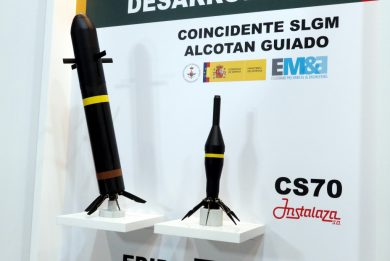
FEINDEF 2025 – Instalaza unveils Hispano MPW, its new 90 mm multipurpose weapon
Answering a need of its customers, the Zaragoza-based Instalaza developed a new reusable rocket launcher in the 90 mm calibre, which allows to use the same ammunition of the C90 as well as some new extended range ammo purposely developed for the new Hispano

Maintaining the same calibre and allowing customers who still have in their stock C90 ammunition to use them in the new weapon was certainly a winning move, considering savings as well as logistic considerations. However the new Hispano gives its best when using the newly developed ammunition, that extend the range from 350 to 650 metres.

The weapon is built around a smoothbore metallic barrel which is fitted with a protective fabric that also allows reducing thermal signature; the ammunition is inserted from the back, one lock keeping it into place while two sets of electric contacts allow the round to communicate with the fire control system (FCS), the latter recognising the type of round and automatically selecting the right ballistic table. The loader has only to push the ammunition inside the tube until the lock does not block it. Not only, the sensor measuring the temperature of the rocket motor propellant sends it to the FCS, the temperature influencing the thrust hence the muzzle speed.

At the rear of the tube, on the right side, we find a black box containing the electronics, while the FCS is located on the left side, ahead of the pistol grip. The FCS features a grip, with buttons and joystick allowing to select menus and commands. The FCS was developed by Instalaza, as well as the whole electronics. The FCS not only provides the corrections, the shooter needing only to put the aiming point over the target, its sensors measuring accelerations on the three axis allow to calculate the angular speed of the target, the laser rangefinder providing the distance.

It features a day/night sight, with an optical channel and a thermal channel, the latter based on an uncooled LWIR sensor, the image being fed into a colour display with an x3 magnification. Installing the FCS on the weapon is very simple; the module slides on a rail, from the front towards the rear, and when it reaches the end of the slide a central button is rotated counter-clockwise for 270°; this rotation makes a small cylinder to protrude from the flat side inside the slide to engage a recess in the weapon, ensuring electrical connection between the launcher and the FCS. The FCS has a mass of 1.7 kg including six CR123 batteries.

The company developed a red dot backup sight, which features range regulations for three types of ammunition. Should a customer decide not to acquire the FCS, Instalaza proposes its series of E-Ivision sights, which do not feature the thermal imager, and are available in different configurations. The weapon mass is 5.8 kg with the backup sight and without the FCS. Its length is under 1 metre, which allows paratroopers to jump with it.

Speaking of the new extended range rounds, these have a two-stage propulsion system, a rocket motor accelerating the round in the launch tube. The booster then separates from the round, which continuous flying under the thrust of a sustainer motor that ensures the speed remains nearly constant, at around 200 m/s. The propulsion system is derived from that of the Alcotan launcher. Constant speed and a careful aerodynamic design contribute to reduce the effect of side wind on the round trajectory, according to Instalaza.
EDR On-Line understood that the first 90 mm extended range munition to be developed is the antitank one, which warhead has a single shaped charge. Two more rounds are available, no details being provided. Instalaza counts to ink the first contract within 2025; beside being exhibited at the Instalaza stand, the Hispano could also be seen on that of the Navy, clearly aiming to the Tercio de Armada, the Spanish naval infantry unit.
As for the name of the new multipurpose weapon, this comes from Ukraine: according to Escribano the Ukrainian soldiers appreciate very much the C90s they have received, which they call Hispano, for Spanish. To pay respect to the Ukrainian fighters the Zaragoza company decided to give the C90 nickname to the new weapon.
Photos by P. Valpolini



